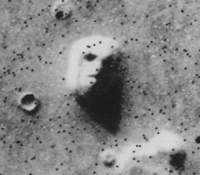
Why do we see faces in everything? We see faces in everything because it is far better to think there is a face in the forest and be wrong than to not think there is a face there and be eaten by a tiger.
Seeing faces everywhere is called pareidolia. This is Greek. “Para” means “instead of” and “eidolon” means “shape”. This word doesn’t just refer to seeing faces everywhere, but seeing patterns and shapes that are not there. You can see this every day for yourself. People hear voices in the wind, we see faces in the fronts of houses, we find patterns in random strings of numbers, see shapes in the clouds, see a face in the moon, and we connect events that are not linked. Pareidolia is something that all of us have experienced at some point, but it can lead to conspiracy theories and the gambler’s fallacy, which is where gamblers assign reason to strings of numbers that are not connected.
Experiments have been carried out on people in various types of brain imaging machines to see what happens in their brains when they see an image that could be a face. MRIs, EEGs, and MEGs (magnetoencephalography – a way of recording the magnetic fields produced by electric currents produced in the brain) all show that the face recognition center of the brain fires almost as quickly when we see something that resembles a face as for when we see an actual face. The MEG showed that when we see a real face, the face recognition part of our brain fires in 130 ms and when we see an image of something that merely resembles a face, it fires in 165 ms. Another interesting discovery is that our brains realize the image that merely resembles a face isn’t really a face, but still continues to spend mental energy analyzing it. That means the face recognition part of the brain fires when it sees a rock that looks like a face, realizes it isn’t really a face, but then carries on trying to work out what emotions the face is displaying. So, why do we see faces where there aren’t any, and why does our brain carrying on trying to analyze them?
There are 3 reasons, and they are all evolved traits. The first is that the ability to see faces helps us avoid being eaten by a predator or find food. We don’t have to worry so much about being eaten by a bear, or having to hunt and kill a woolly mammoth so much these days, but the time when we did is not so long ago. Our brains are hardwired to see faces because often it is something we need to run away from as fast as possible. We are not the only animals that do this. Many animals recognize and run away from faces. Some animals even use this to their advantage and have faces on their backs as camouflage. We often see faces were there aren’t any because of natural selection. Ancient people that ran away from real faces and from imagined faces as well were more likely to survive and pass on their genes. There are times when imagined faces could turn out to be real faces.
The second reason is because we have evolved to live in groups. When living in groups as social animals, we need to be able to read the intentions of the other people around us. We need to know if someone is a friend or a foe very quickly because it could be the difference between life and death. This is why our brains linger on the imagined face, even after we have worked out that it is not real. Our brains recognize faces and then try to work out what that face is intending to do.
The third reason is to do with the way we see the world. Our brains don’t have enough capacity to analyze everything we see or hear, so it takes shortcuts by looking for patterns. Finding a pattern can make it easier to work out what is happening. And we have evolved to be very aware of patterns. If you listen to random noise with real speech thrown in to it, you will hear the words because your brain is looking for patterns and things you already recognize. And most of the time this works incredibly well and we can hear what our friends are saying to us in a crowded bar. And other times it doesn’t work quite so well and we think we hear words coming from a squeaky door. Still, it’s better to have our brain find patterns where there are none if it means we can find patterns where they exist. And this is what I learned today.
Try these’
Sources
https://www.bbc.co.uk/newsround/57751620
https://en.wikipedia.org/wiki/Pareidolia
Image By Viking 1, NASA – This file has been extracted from another file, Public Domain, https://commons.wikimedia.org/w/index.php?curid=850538
